How to Put 2 Month Old Baby to Sleep

Sitting on the couch with my swollen legs propped up on pillows, I looked over at the stack of newborn baby sleep books on the coffee table. Over the course of several hours, I devoured each book, skimming through the pages.
I was determined to learn how to make a newborn sleep.
Then…my son was born.
And….he didn't sleep.
Imagine that. A baby not sleeping the way a book says 🙂

I fumbled through it the first six weeks. I was so unsure of myself.
Thankfully, we pulled ourselves together, armed ourselves with some key infant sleep facts, developed a plan and implemented it.
We stuck with it, and at 4 months old, our son was sleeping 11-12 hours at night and naps extended to 1.5 to 2 hours. Woohoo! We've experienced sleep regression, sleeping on the go, sleeping through teething…and so much more!
post contains affiliate links for your convenience.
How to get a newborn to sleep.
Getting your newborn to sleep longer stretches at night is not a perfect process. There is an ebb and flow. It's all about trying new things and finding something that works well for your baby.
We used these tips for our daughter, and she slept so well during the newborn phase, my husband and I enjoyed a generous amount of time hanging out.
Here's the best part: When your baby sleeps better, you will notice a more patient, more tolerant, more engaging baby after a good night's rest or quality nap.
1. Swaddle
From birth to about age four to five months, babies innately possess a startle reflex, in which they feel as if they are falling. The sensation of falling causes jerking movements, and the baby will incidentally wake up.
Keeping a tight swaddle prevents babies from startling themselves awake, helping the newborn baby sleep both better and longer. I like to think of the baby as 'snug as a bug in a rug,' and I used to tell my son this every time I'd swaddle him snugly.
I love the HALO SleepSack Cotton Swaddle but the Woombie is amazing too!
Both help keep the baby swaddled snugly yet safely.
Even if your baby seems to dislike the swaddle I would keep trying. If you think about how it was for them in the womb, it is a very familiar feeling for a baby to enjoy a snugness around them.
We stopped swaddling once our son could regularly get his arms out and roll over. We continued to use the Halo Sleep Swaddle and just swaddled around his torso, leaving his arms out.
2. Dreamfeed.
The dreamfeed is the feeding given to the baby right before you (mom or dad) go to bed, and it helps prevent the baby from waking up just after you finally drift off to sleep.
Isn't this the pinnacle of sleep deprivation?
You just fall asleep and the baby wakes up.
The dreamfeed can help your newborn baby sleep for longer while you sleep. We used it until about age 4 months. After than time, it can start to disrupt sleep and create more nighttime waking.
Here's an example of a newborn sleep schedule that we loosely used during the first 3-12 weeks.
- 7 am – Wake up, eat, play
- 8 am – Nap
- 9:30 am – Wake up, eat, play
- 10:30 am – Nap
- 12:00 – Wake up, eat, play
- 1:00 pm – Nap
- 2:30 pm – Wake up, eat, play
- 3:30 pm – Nap
- 4:30 pm – Wake up, eat, play
- 5:30 – Cat nap
- 6:00 pm – Wake up, eat, play
- 7:30 – Eat again (cluster feed), then down for the night.
- 9:30 pm – Dreamfeed.
- 9:30 pm – 7 am – night feeds as needed.
Generally if you can get a newborn to go 3-4 hour stretches during the night from birth to 6 weeks that is pretty good! From 6-12 weeks if you can get a 4-6 hour stretch that's great. Some babies will go 8-9 hour stretches with the dream feed.
When most author's taut "getting baby to sleep through the night" they are referring to a 6 hour stretch of sleep. A newborn's stomach is very small and I typically like to feed at least 2.5 hours during the day, cluster feed in the evenings AND dreamfeed. The more calories you're able to feed during the day, the less they may need at night.
If you're looking for more baby sleep schedules, check out my book Routines, Rhythms and Schedules. Inside there are 20+ printable schedules from birth to age 5.
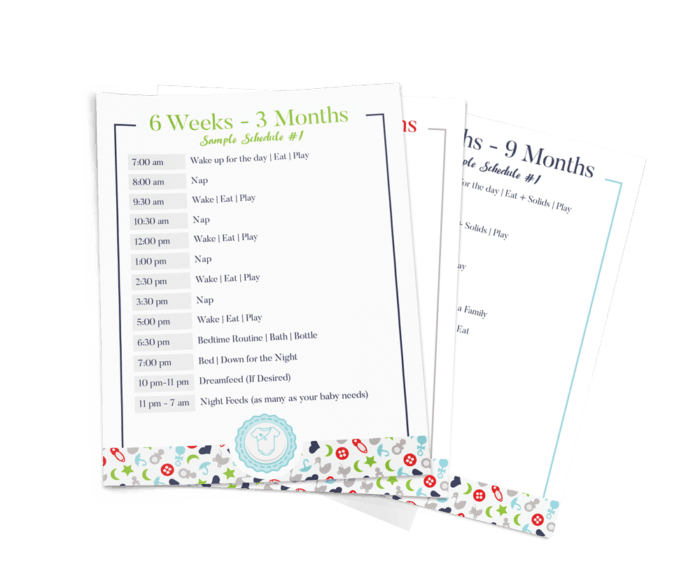
3. Limit the length of naps during the day.
I know it's hard to wake a sleeping baby, but sleeping too long of a stretch during the day can rob nighttime sleep. If the baby sleeps past the 2 – 2.5 hour mark, I would go ahead and wake the baby up, feed him, keep him a wake for a bit, and then lay him down for another nap. If you feel the baby truly needs longer naps, feel free to increase the nap limit to 2.5 hours. Breaking up sleep during the day will help your newborn baby sleep better at night. It also enables you to get more feedings in during the day, which is very helpful.
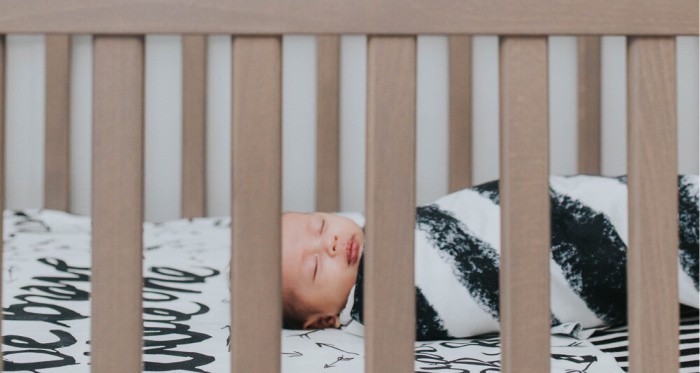
There were, of course, times where our son was overtired and needed a little recovery nap. We would allow him to sleep for a little bit longer for just that one nap and then we started getting back on track with our daily routine.
Related: How to Help Baby Take Longer Naps
4. Use white noise.
No one wants to miss a party, so if your baby is listening to all the fun going on in the house it can be hard to fall asleep and stay asleep.
I place a fan on medium in the baby's room rather than directly next to the baby, so it does not blow directly on him or sit too close to his sensitive ears. Using white noise also helps immensely when we are traveling! We are usually able to avoid asking friends or family to be quiet 🙂
I've used both a regular fan and a white noise machine in the past.
5. Follow the eat, wake, sleep cycle.
The baby wakes from sleep and immediately eats. Then the baby is awake for a while to play. Then the baby goes back to sleep….
This cycle has several purposes. First, it encourages full feedings by allowing the baby to eat immediately after waking. The baby will have the most energy immediately after waking, making him more inclined to take a full feeding and go longer between feedings.
Also, by feeding the baby after sleep rather than before sleep, the cycle prevents the baby from associating food with sleep or using food as a sleep prop. When using this cycle, a feeding before bedtime is typically only feeding before sleep.
Of course, there were times where I definitely fed my baby before sleep. He needed a little TLC for a certain nap, and I was totally fine offering it when he needed it. But for the most part, I tried to avoid feeding him right before sleep.
Note: Newborns require frequent feedings and rest to ensure healthy growth a development in the early months. Always feed your baby as frequently as your baby needs to ensure healthy weight gain.
6. Use a pre-nap and bedtime routines.
It is well known that babies thrive on routine, structure, and predictability. Routines are also an excellent tool to help newborns get settle before sleep at night. Creating consistent routines will help bring order to a very chaotic world for your infant.
Choose a pre-nap routine that works for you.
A pre-nap routine may include taking the baby to his room, close the blinds or curtains, place the baby in his sleep sack or wearable blanket, turn on the white noise, sing a quick song (e.g. Twinkle, twinkle), give a few cuddles, and say your sleepy words "I love you. I hope you have a good sleep."
A bedtime routine would typically be a little longer.
It may include a bath, a massage, reading a story, offering a feeding, placing the baby in a wearable blanket or swaddle, turning on the white noise, a few cuddles, and saying your sleepy words. Following the same exact routine as consistently as possible cues the baby for sleep, and over time the baby will learn that sleep immediately follows the nap and bedtime routines.
Use these printable (and adorable!) baby sleep routine cards to keep parents, grandparents and babysitters ALL on the same page.
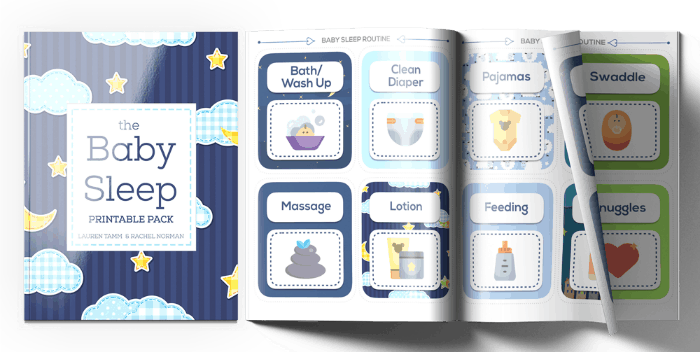
Inside the baby sleep printable pack, I also include a chart to help you know how much a newborn should sleep. It's a great resource to use when creating your own custom newborn sleep schedule.
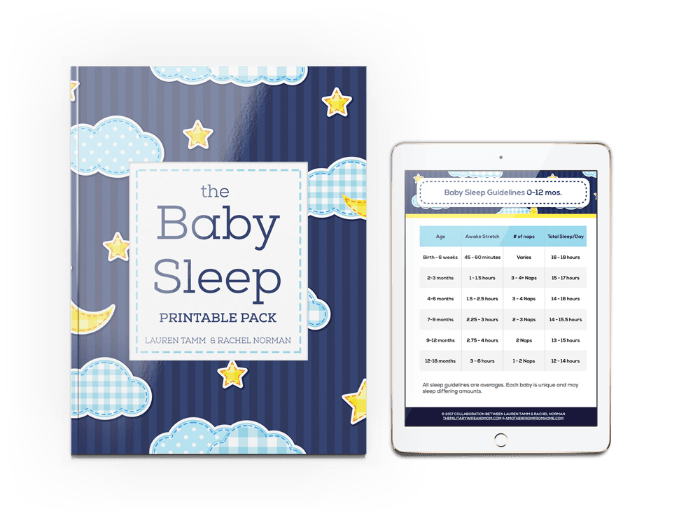
7. Change your baby's diaper strategically…
Changing the diaper before a middle of the night feeding prevents the baby from waking up too much after a feeding is finished. When the baby wakes up change the diaper and re-swaddle to prepare him for sleep immediately following a night feeding. If you change the diaper after the night feeding, the baby may become too awake, making it more challenging for him to fall asleep.
Now, I've also heard from parents of very young newborn babies (Think: Birth to 3 weeks) sharing that the baby poops right after a night feeding. This is very common during the early newborn phase when babies are still working out the flow of their digestive tracts.
If your baby is consistently stooling after a night feeding, then certainly, just wait to change the diaper until after the feed. Once your baby's gut matures and he or she stops stooling immediately after a night feed, you can go back to changing the diaper before the feed.
8. Understand how a baby sleeps.
The more your baby sleeps, the more they will sleep.
It's backwards but true!
If your newborn won't sleep, there's a very good chance, he's way overtired.
Keeping a baby awake in hopes of tiring him out will actually result in over-stimulation, and he will experience both difficulty falling asleep and staying asleep. It is very likely an overtired baby will sleep shorter, not longer.
Note: Sometimes this tip confuses readers. And it's no wonder. First I said limit naps during the day, and now I said an overtired baby will sleep shorter, not longer.
Let me be more clear:
- Limiting the length of naps is important to support night time sleep. You want the baby to get in as many feedings as possible during the daytime. Think: More daytime feeds = less nighttime feeds.
- You don't want to keep the baby awake for long stretches. Your baby will get over-tired, fussy and have difficulty falling back asleep.
- Bottom line: Encourage lots of naps AND feedings during the day following the eat, wake, sleep cycle.
Related: 8 Infant Sleep Facts Every Parent Should Know
9. Don't rush in…
We may inadvertently encourage the start of a bad sleep habit by rushing in when a baby cries or rustles during the night. Often times, babies wake up babble and go back to sleep.
The baby may even cry briefly or babble and still be asleep.
Give the baby some time and see if he will resettle himself. Avoid rushing in and disturbing this process in order to help your newborn baby sleep better.
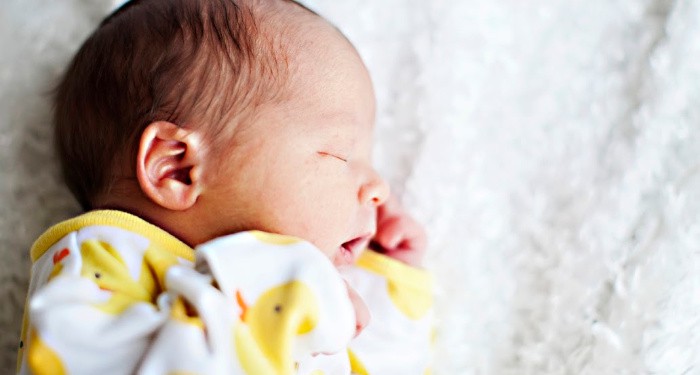
Waiting anywhere from 2-10 minutes to see if your newborn settles is a good place to start. There's no exact science. Listen to your baby's cries. If your baby is starting to escalate, it's usually a good sign he needs some extra comfort and support.
10. Lay the baby down awake, but drowsy.
The most important way to encourage your newborn to sleep in the long run is to teach him to fall asleep independently, which is essentially the beginnings of teaching independent sleep.
Babies, like adults, will naturally wake up during the night. Without knowing how to get back to sleep, a baby will cry out after waking regardless of actual need, resulting in night waking droning on for much longer than is actually necessary.
Once a baby gets older, falling asleep independently enables a baby to drift back to sleep after waking in the night, ultimately helping your baby sleep better in the long run.
You can start by settling your baby into a drowsy state with your newborn baby routine, then lay your baby down in their safe sleep space. If needed, place a gentle but firm hand over your babies chest while he drifts off.
Print your free baby sleep checklist!
Chances are…you won't remember the tips from this post. This printable simplifies it! Plus, when you grab this printable, you'll get instant access to my free 3-day baby sleep eCourse.

Download your free printable
- Download the checklist. You'll get the printable straight to your inbox, plus get myFree 3-Day Baby Sleep eCourse!
- Print. Any paper will do the trick, but card stock would be ideal.
- Place it on your refrigerator. Use it as a quick reference and don't forget a thing!
Want more on baby sleep?
- 8 Infant Sleep Facts Every Parent Should Know
- The Newborn Routine That Will Help Baby Fall Asleep Fast
- This Baby Bedtime Routine Is Easy and Works Like Magic
- 6 Tried and True Baby Sleep Schedules That Parents Love
I've created a free email series just for you! If you are struggling with finding a routine, rhythm or schedule, this email series will help you find one that will work for YOUR family. Yes, really. I've seen my sample routines work time and time again for parents. I know it can work for you too.
This free email series will help you:
- Free sample routines for your child
- Best morning routine tips and tricks your kids will actually follow
- All-time favorite parenting hacks for getting more cooperation at bedtime
- Step-by-step guide for using a printable daily schedule with kids
Click here to sign up!
Are you new to this community? Start here, friend.
How to Put 2 Month Old Baby to Sleep
Source: https://themilitarywifeandmom.com/starting-babywise-top-10-newborn-baby-sleep-tips/
0 Response to "How to Put 2 Month Old Baby to Sleep"
Post a Comment